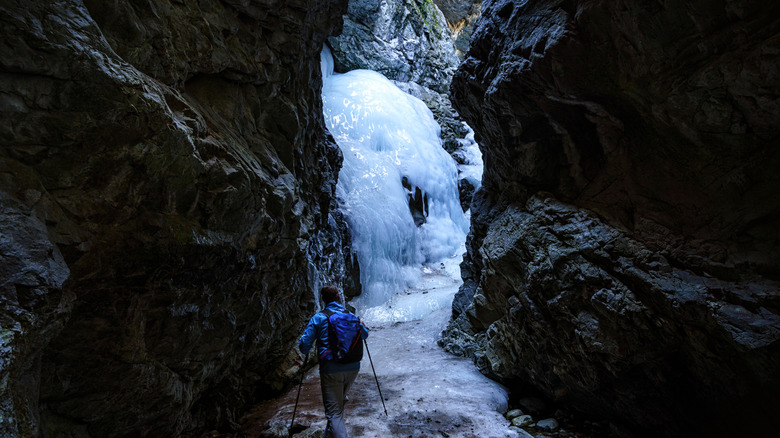Get Off-The-Beaten Path At Colorado's Secret Waterfall Near Great Sand Dune National Park
Some of the best skiing in the United States can be found in Colorado, but there's more to its majestic landscape than snowcapped peaks and fresh powder. Zapata Falls, which is tucked away at the base of the Sangre de Cristo Mountains just a short drive from Great Sand Dunes National Park, is a prime example of the diversity of Colorado's natural beauty. So, if you've had your fill of soaring mountains and aspen groves, this is the ideal way to explore a lesser-known side of the Centennial State.
Getting to Zapata Falls is relatively easy for most visitors, though it's a bit of a trek if you're coming from Denver. You'll drive south for nearly four hours before stumbling upon the crevasse in the Sangre de Cristo Mountains housing the 25-foot waterfall. But with a nearby campground that's open year-round and quick access to the sand dunes, there are plenty of adventures to keep you busy in southern Colorado.
Take the short hike to Zapata Falls
Zapata Falls is located off a dirt road just south of Great Sand Dunes National Park. After parking in the lot and soaking in distant views of the dunes, you'll hike about a half mile one way to reach Zapata Falls nestled into a narrow gorge. As you inch closer to the falls, the rocks can become slick with water and you may have to wade into the stream, so be sure to watch your step and pack the appropriate footwear. Traction devices, such as spikes, are highly recommended in the winter.
Want to avoid the Colorado crowds? Winter is the best time to visit Zapata Falls. Along with fewer people, you'll get to see the falls when the rushing water is frozen solid. Similar to Ouray, an awe-inspiring mountain town in southwestern Colorado that's known as the "Switzerland of America," Zapata Falls is a popular destination for ice climbers when it freezes over — so if you see hikers on the trail with an ice axe, you know you're in for a dramatic view.
Birders are in for a special treat when visiting this hidden waterfall, as it's home to a colony of Black Swifts. They're a bit elusive, so consider visiting near dawn or dusk to spot them zipping around. You'll have to get lucky to see a Black Swift, but other birds like American Dippers and Western Scrub-Jays are easier to spot during your hike. Keep your eyes peeled and your camera ready long before you reach the falls.
Spend some time in Great Sand Dunes National Park
At less than one mile long, the hike to Zapata Falls won't take you more than 30 minutes. That means you'll have plenty of time to explore the rest of the landscape — and there's no better place to start than the tallest dunes in North America at Great Sand Dunes National Park. The dunes are a quick 15-minute drive away and, because it's open at all hours (and year-round), it's remarkably easy to fit into your schedule.
Unlike most national parks that require you to stick to designated trails, Great Sand Dunes National Park lets you freely roam the entire 30-square-mile dunefield. You won't find any premade trails carving through its rolling landscape, making it a truly unique experience. The sand can get dangerously hot during the summer, so while the park is open around the clock, plan to do most of your hiking in the early morning or evening to avoid surface temperatures up to 150 degrees Fahrenheit. When you need a break, head back to the Zapata Falls Campground, which offers numerous campsites and stunning views.
Another unique feature of this national park is Medano Creek. When snowmelt begins rolling off the mountains, the creek swells to massive proportions to create what's known as "Colorado's natural beach." You'll find a large, flooded section of the dunes that's perfect for cooling off on a hot summer's day, with late May seeing waves that can reach up to 20 inches tall. To avoid overcrowding, visit on a weekday when you're more likely to have space to enjoy the natural phenomenon.


